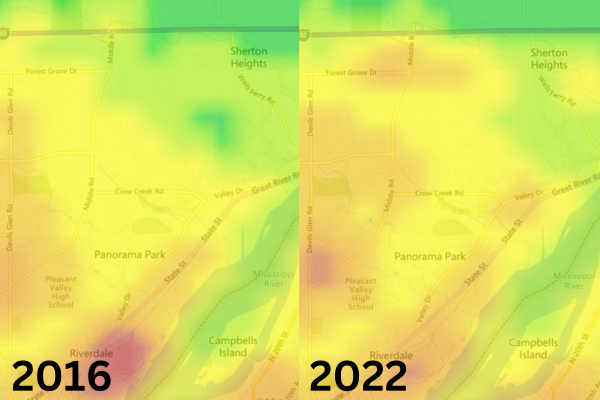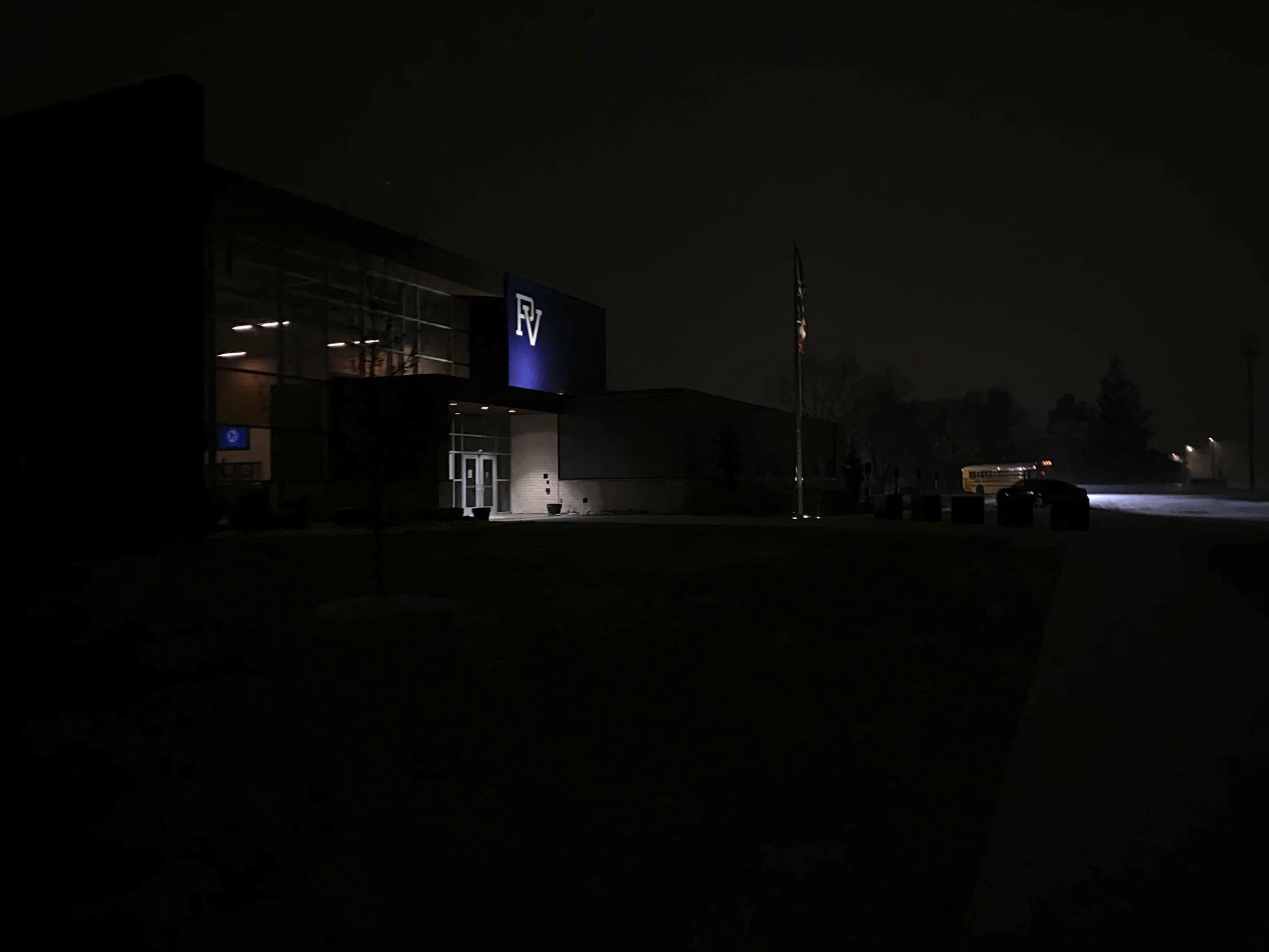When most PV students look up at the night sky, they are lucky to see even a couple of stars. After a few minutes, they may see a couple dozen. But never anything more.
Star-curious PV students must make a 40-minute drive to the Menke Observatory for their monthly observing nights with the Quad City Astronomical Society. That’s 40 minutes of driving just to reach decently dark skies.
This phenomenon of star-less skies is known as skyglow, and it is a result of light pollution. For decades, light pollution–the remains of excess light released from lit-up buildings and street lights in developed areas–has dimmed the starlight above inhabited and even rural regions across the globe. As cities grow, technology develops, and private companies launch more satellites, skies continue to artificially brighten at a rate of 10% each year.
Light pollution from the ground
The largest contributor of skyglow is excess ground-based lighting from streetlights, residences, and high-rises, which pollute nearby rural areas. Although only 56% of the global population live in cities, nearly 80% live under light-polluted skies. In the United States, that number rises to 99%.

The World Atlas of Night Sky Brightness, released in 2016, is an online program that maps the distribution of skyglow across the globe. A quick comparison of the 2016 and 2022 maps shows a subtle but clear increase in the skyglow above Bettendorf, with skyglow seeping into Sheraton Heights and a notable “red area” developing around Forest Grove Drive where the TBK Bank Sports Complex was built.
AP physics teacher Ian Spangenberg, who also hosts the PV Astronomy Club, mourned the scientific loss at the hands of light pollution. “Some of the biggest crowning achievements in astronomy were made by Hubble in the 1920s. But his work was done at the Mount Wilson Observatory in Los Angeles, which you can’t do astronomy in now. All our ground-based telescopes have to be in the desert or in the poles,” explained Spangenberg.
Spangenberg noted that by forcing telescopes to operate in remote areas, costs of transportation, maintenance and research increase. Additionally, by limiting research to these areas, only certain regions of space become observable from the ground. “How much science are we losing because we can’t operate telescopes in accessible areas?” asked Spangenberg.
According to DarkSky International–a non-profit organization aimed at mitigating the effects of light pollution–light pollution is also expensive in itself. Approximately 35% of nighttime lighting is ultimately wasted, which costs the U.S. $3 billion worth of energy each year.
There is also a notable cultural loss, as constellations and stars are culturally significant and even sacred for many Indigenous groups. A 2020 essay printed in the Journal of Dark Sky Studies even classified the effects of light pollution as a form of cultural genocide, citing the waning visibility of the celestial emu–the Milky Way–which is the most widespread asterism across aboriginal Australian groups.
For Dr. Robert Gregory, who taught astronomy at PV this fall, the worst consequence of light pollution is biological. “The loss of or infringement upon the circadian rhythms [as a consequence of light pollution] that are so important to society are having a significant impact on society,” Dr. Gregory explained. “We now know, for instance, that both animal and human behavior are modified by the lack of true day/night cycles, and that stress recovery is hampered by these circadian impairments.”
Continuous nighttime light exposure has also been linked to lower levels of melatonin production, which increases the risk of cancer.
Light pollution and the satellite boom
When Starlink first began launching low orbit satellites in 2019, the satellites’ brightness and prevalence in the night sky were staggering. Almost four years later, the number of Starlink satellites has increased from 6o to over 4,000, becoming an almost unavoidable element of the night sky. As for the satellite industry as a whole, the number of satellites in orbit has more than doubled, going from 3,000 to well around 8,000.
These orbiting satellites tend to form satellite constellations interrupting visual astronomy. Low-Earth orbit (LEO) satellites like Starlink, tend to also interfere with radar astronomy, as they orbit much closer to ground radar receptors than their counterparts.
“The eventual goal [of Starlink] is 42,000 satellites,” explained Dr. Gregory, citing his own struggle trying to avoid satellites while conducting recreational astronomy. “This will brighten the sky by a factor of 2 to 3 at full deployment.”
Unlike ground-based light pollution, satellite light pollution would seep into rural and otherwise dark skies, fundamentally changing the landscape for ground-based astronomy. When considering collision risks of LEO satellites, environmental impacts also become a concern.
While the US Federal Communications Commission has only approved a fraction of Starlink’s proposed satellite launches, the ambition resembles a growing trend in communications service satellites. Currently, communications satellites outnumber observational satellites three to one, and the disparity is only expected to increase. Scientists estimate anywhere from 100,000 to 400,000 satellites may be deployed by private industries in the coming years if left unregulated by entities like the Federal Communications Commission. Many of these satellites would also be larger and closer to the surface, offering further disturbance to ground-based astronomy.
Dr. Gregory attributed the trend to changed attitudes regarding private funding. “[A] disregard for the traditional monetary rules of investment has made its way into just about every area of investment today,” said Dr. Gregory. “Space entrepreneurship is no exception.”
The cost of satellite production and deployment has also become more institutionally affordable. With satellite costs dropping by a factor of 95%, satellites have easily become a new frontier for the communications industry.
“The idea is to get rid of, or at least eliminate the need for new wire-based information transmission over the internet, with Musk owning the conduit for this concept,” Dr. Gregory mentioned. “Think of it like the days of Bell Telephone and MCI, who battled over who would own the wires used for long-distance telephone and data transmission.”
Although this race for the skies offers an array of technological expansion and development, especially by providing internet access to remote areas, it is also at the expense of the night sky.
“It’s the destruction of the commons,” said Spangenberg. “[Space] is a common good that everyone owns–it is a common space. But the more satellites you put up destroys that common good, although it’s for good reasons like phones and GPS.”
But Spangenberg is hopeful that science and industry may co-exist. “It could be cool if private businesses, as they destroy the commons, actually help make up for that. Imagine if a percentage of their profits were used to fund science research and space-based telescopes.” Space-based telescopes like the James Webb Space Telescope offer unique astronomical imaging opportunities regardless of light pollution.
“Many times, when we have forced developers to redesign their innovations, there is a synergistic improvement in the function of those designs,” explained Dr. Gregory, who although skeptical of the increasing industrialization of space, believes proper regulation is possible. “Environmental impact statements come to mind, as do the dark sky projects that have been successful. Every design should incorporate that kind of impact evaluation. I hope that we will have the foresight to do it.”
The threshold for effective ground-based astronomy under skyglow is a brightness factor of 10%. For now, many remote areas around the globe still operate in conditions below that 10%. But as satellites begin to threaten even the world’s darkest skies, it seems that a consensus must be reached between science and industry, or the future of ground-based astronomy, like the dimming stars themselves, may be up in the air.











Luke Shamrell • Feb 4, 2024 at 11:34 pm
I have been through Spangenberg’s classes and gained a decent interest in astronomy from it. I’ve been able to travel around the country to find some rather dark areas, such as Zion National Park. But the thought that even that could eventually be too bright for any meaningful observation is demoralizing. I’ll hopefully be able to travel back around before it gets too bad so I can at least have photos to show what it was like.